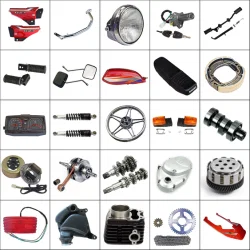Main types of motorcycle transmissions
2023-11-24
The motorcycle transmission is a critical component that transmits power from the engine to the wheels, allowing the rider to control the speed and direction of the motorcycle. There are different types of motorcycle transmissions, and the choice of transmission system often depends on the motorcycle's design, intended use, and rider preferences. Here are the main types of motorcycle transmissions:
1. Manual Transmission:
- Sequential Manual: Most motorcycles with manual transmissions use a sequential gearbox. Riders shift gears in a specific order, typically in an upward or downward sequence using a foot lever. Clutch engagement is required for each shift.
- Constant Mesh: In constant mesh transmissions, all gears are constantly engaged but not fixed to the shaft. The rider engages a specific gear by sliding a collar that locks the desired gear to the output shaft.
2. Automatic Transmission:
- Automatic Dual-Clutch Transmission (DCT): DCT systems use two clutches—one for odd gears and another for even gears. The transmission pre-selects the next gear, providing smooth and quick shifts without the need for rider input.
- Automatic Continuously Variable Transmission (CVT): CVT systems do not have fixed gears. Instead, they use a belt and pulley system to provide a continuous range of ratios, offering smooth acceleration without distinct gear changes.
3. Semi-Automatic or Manually Actuated Transmission:
- Semi-Automatic: Also known as "clutchless" or "paddle shift" systems, these transmissions allow the rider to shift gears without manually operating the clutch. The system may automatically engage the clutch during shifts.
- Quick Shifters: Some motorcycles equipped with manual transmissions feature quick shifters, allowing the rider to shift gears without closing the throttle or using the clutch. Quick shifters are often found in high-performance and sport-oriented bikes.
4. Final Drive:
- Chain Drive: A chain and sprocket system is a common final drive method. Chains require regular maintenance but are efficient in transferring power.
- Belt Drive: Belts are quieter and require less maintenance than chains. Belt drive systems are often found on cruiser-style motorcycles.
- Shaft Drive: A shaft drive system uses a shaft to transfer power to the rear wheel. It requires less maintenance than chains but can be heavier and affect handling.
The choice between manual and automatic transmissions, as well as the type of final drive, depends on the rider's preferences, the motorcycle's intended use, and the desired riding experience. Some riders prefer the manual control and engagement of a traditional gearbox, while others appreciate the convenience and ease of use provided by automatic or semi-automatic transmissions. Understanding the transmission type on your motorcycle is important for proper operation, maintenance, and getting the most out of your riding experience.



